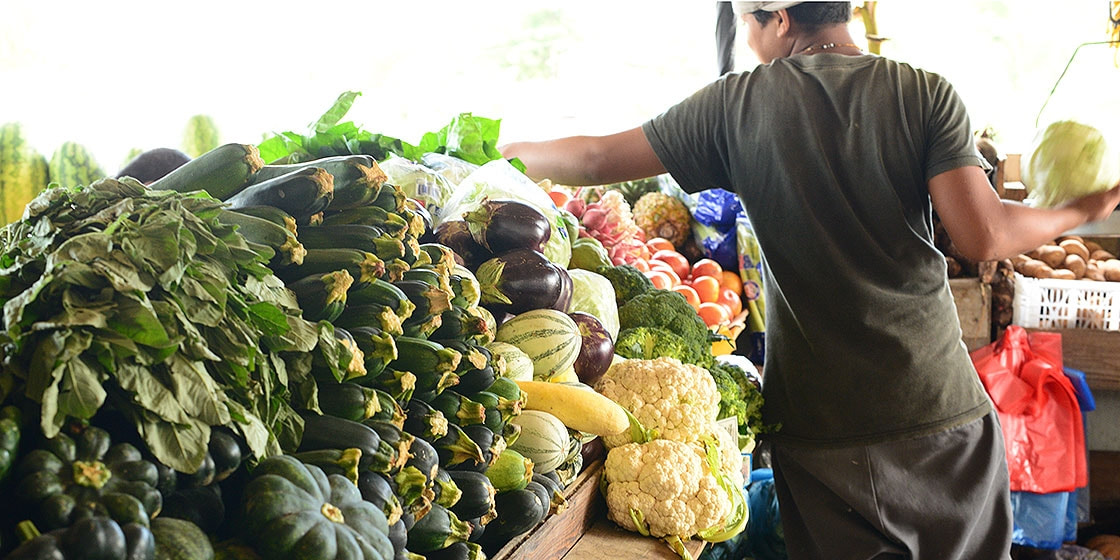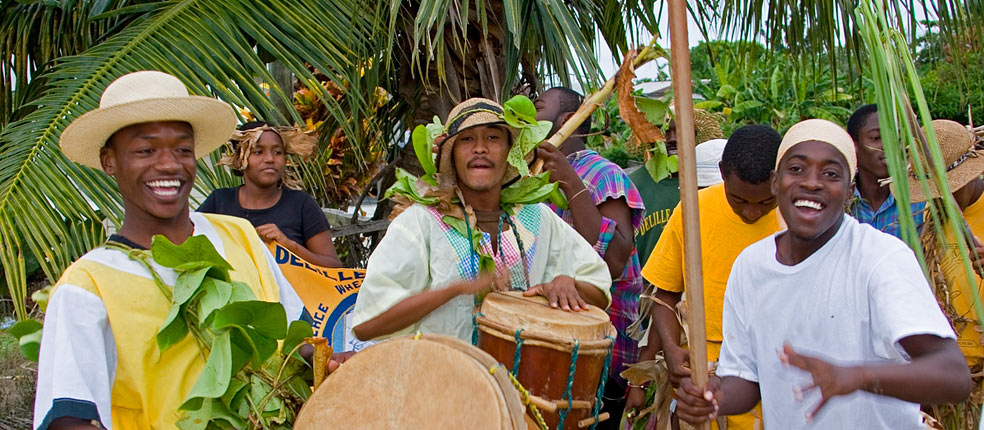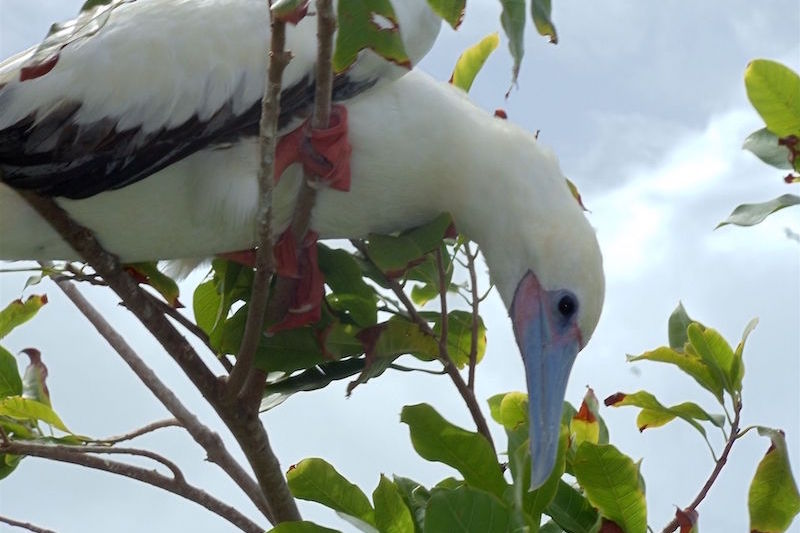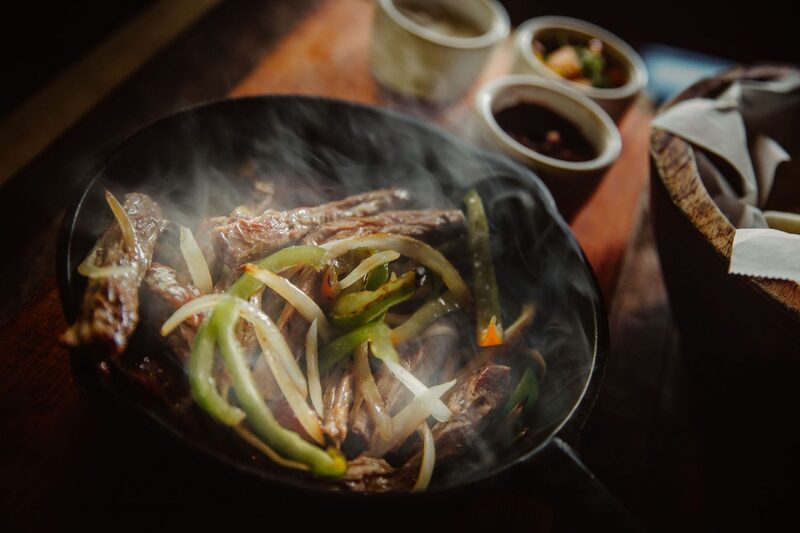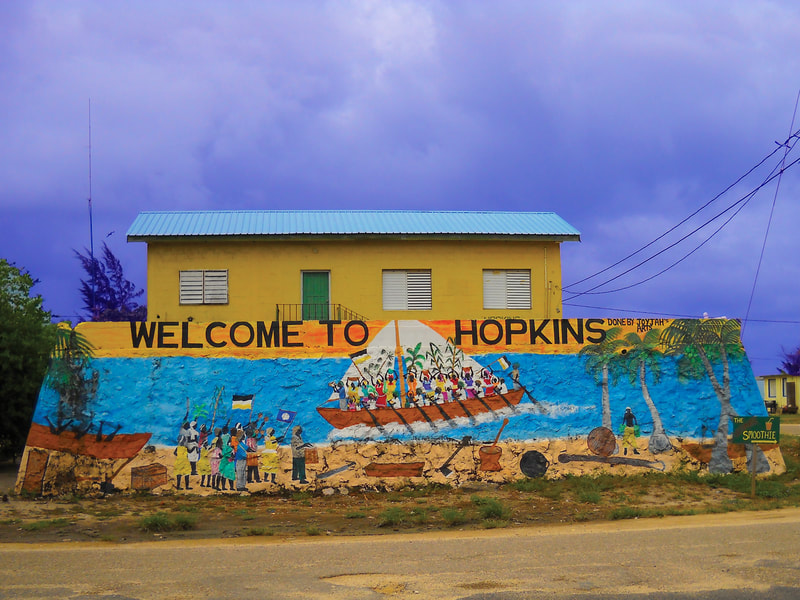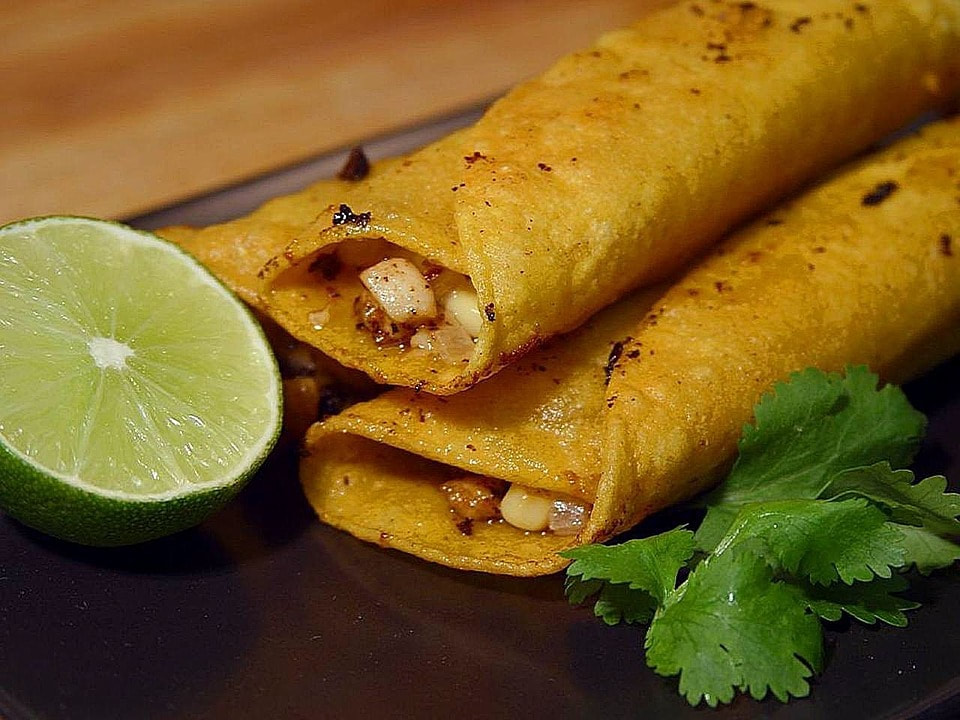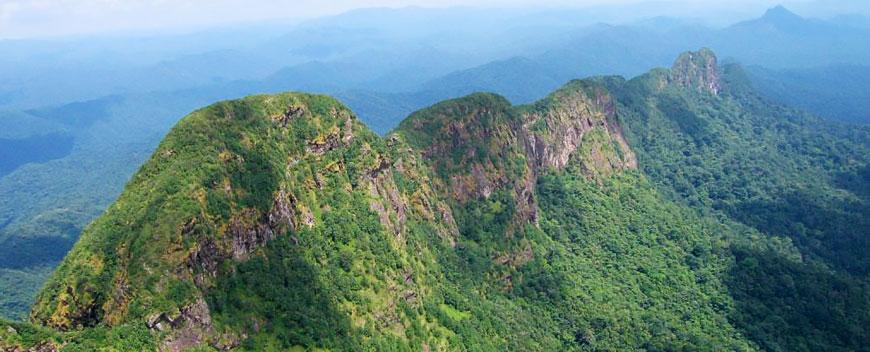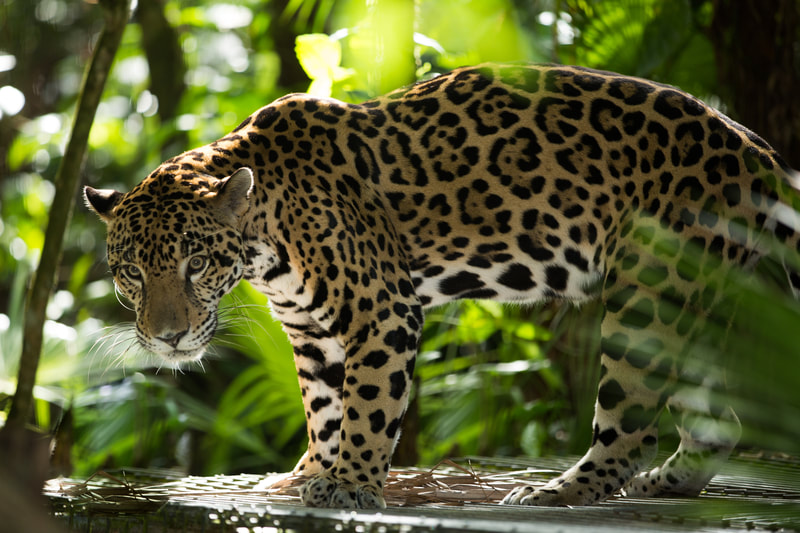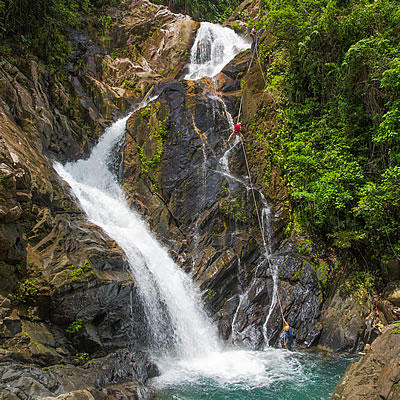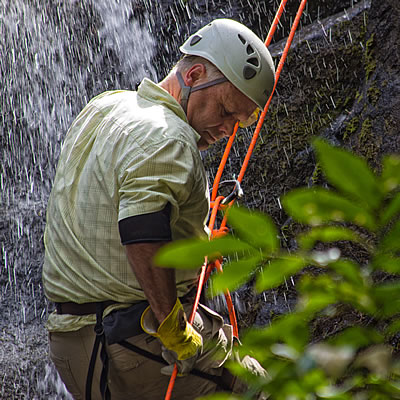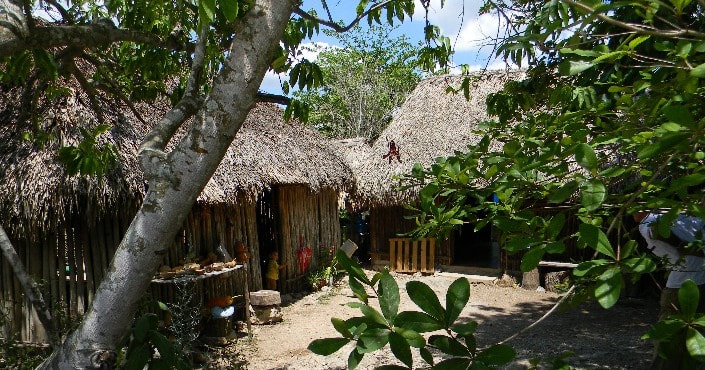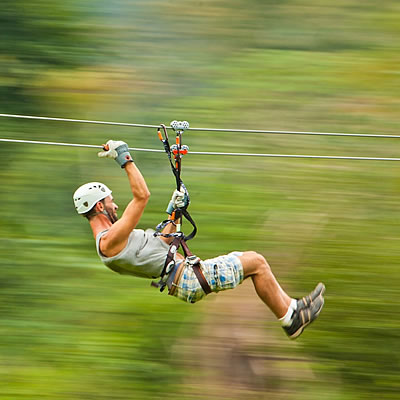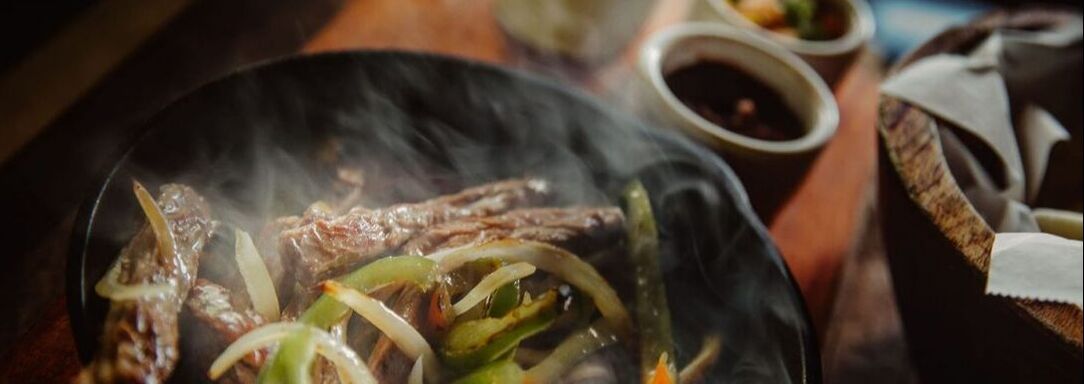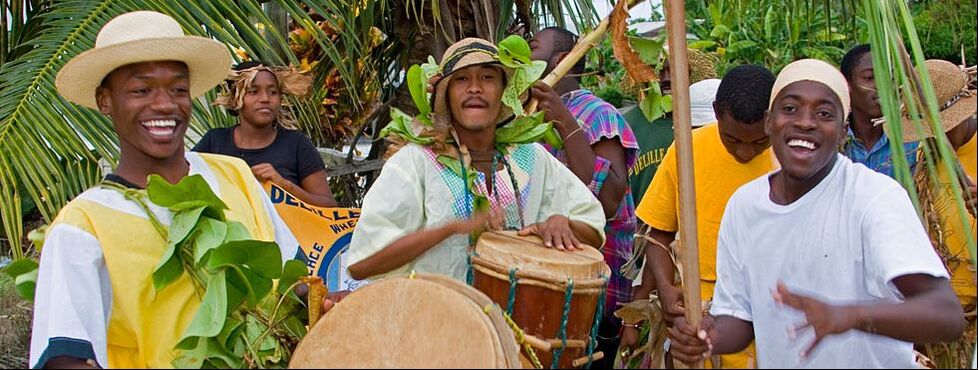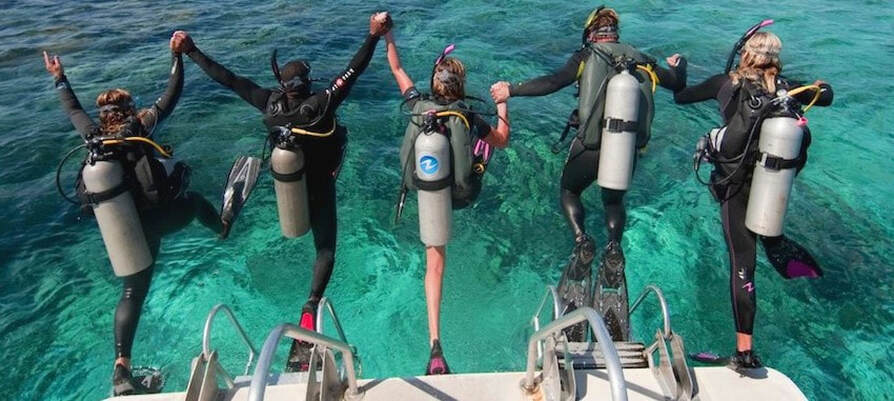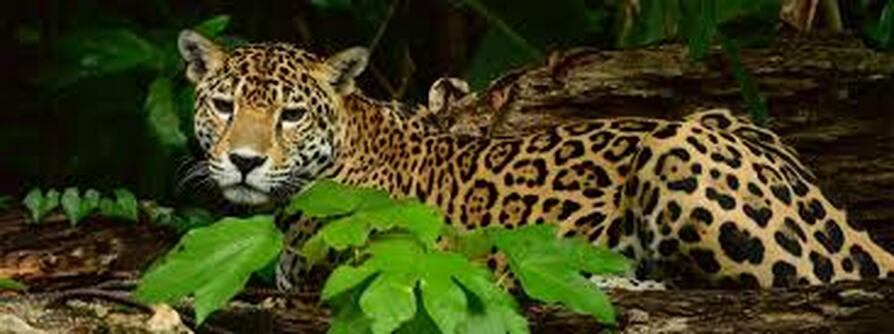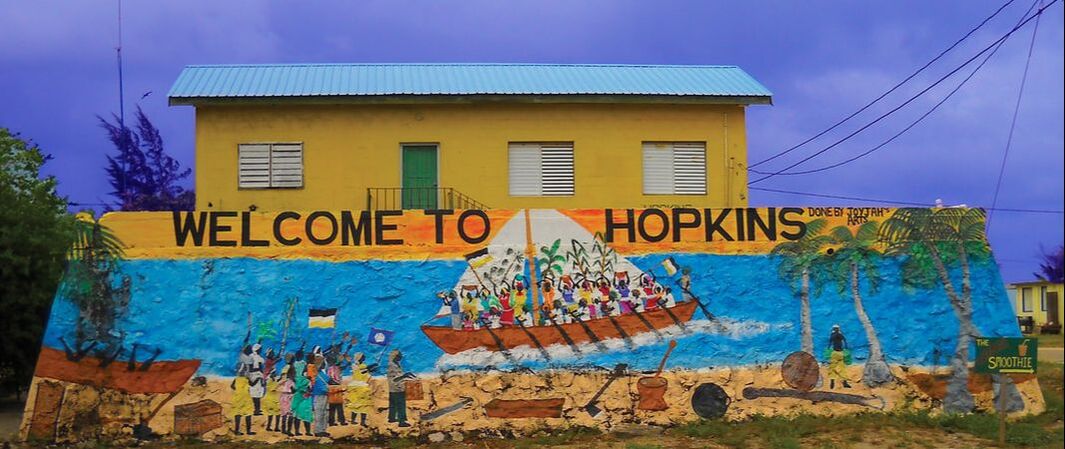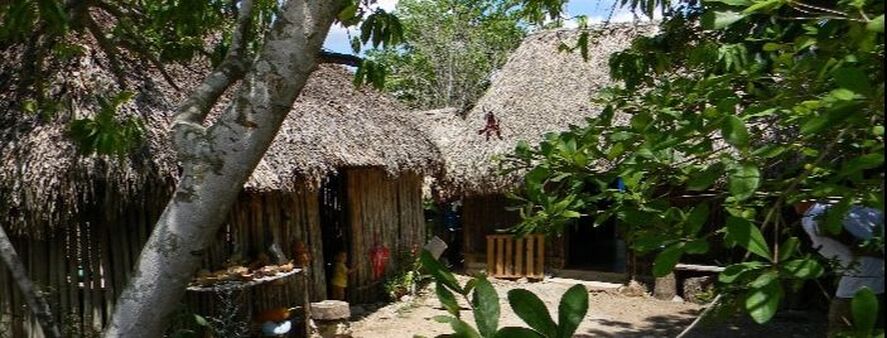STANN CREEK DISTRICT
Why consider vacationing in Stann Creek?
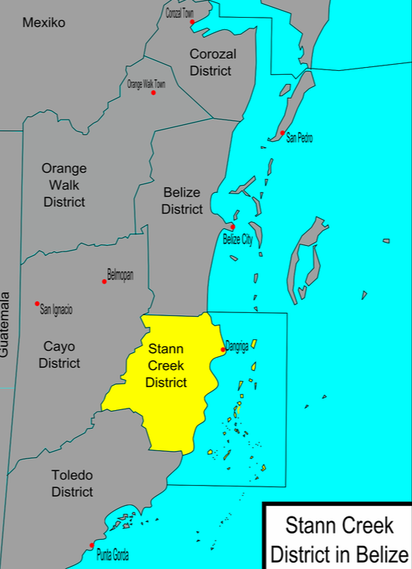
Stann Creek District is a district in the south east region of Belize, with rhythmic cultures of the Garifuna and Maya. Its capital is the city of Dangriga, formerly known as "Stann Creek Town". Located within the district are the port of Big Creek (the main port of Belize's banana industry), the peninsula and village of Placencia (a popular tourist resort), the villages of Independence, Mango Creek, Mullins River, and the Garifuna village of Hopkins on the Sittee River. The Stann Creek District is also home to the Cockscomb Basin Wildlife Sanctuary. Within the preserve is Victoria Peak, the highest point in Belize, at 1120 meters (3,675 feet) above sea level. Stann comes from "stanns", or safe haven used by the colonists coming from the "old world" to the "new world."
Know for its impressive marine reserves and offshore cayes; the inviting tropical rainforest of the world's first jaguar preserve with many species of lush flora and colorful birds; the district also has a diverse selection of tourism attractions and agricultural industries. Arguably Belize's best kept secret, Stann Creek, the country's second smallest district, offers unlimited possibilities for the adventure traveler.
Driving from Belmopan, the picturesque Hummingbird Highway winds its way through the Maya Mountains and into the Stan Creek Valley through rustic rural and communities and the vast expanses of citrus orchards. The turnoff onto the Southern Highway presents new vistas of sprawling coastal plain lined by banana plantations, with the Maya mountains to the west and the Caribbean Sea just over the eastern horizon. The view by air is spectacular, over coastal lagoons and the Gales Point peninsula, low-lying karst hills and uninhabited beaches. Via this route, the first in a series of coastal communities is the district's largest in a series of coastal communities is the district's largest town, Dangriga, followed by the upcoming vistor destinations of Hopkins, Maya Beach, Seine Bight and Placencia.
Offshore lies dozen of white sand and mangrove studded islands, from those that sit a short distance offshore like Laughingbird Caye to Tobacco Caye and South Water Caye that sit right atop the barrier reef. Then, extending some 22 miles east of the barrier reef is Glovers Reef Atoll one of the 4 atolls in the Caribbean. This area encompasses bird sanctuaries for the magnificent Frigate Bird and Brown Booby and two of Belize's spectacular marine reserves, South Water Caye Marine Reserve and Glovers Reef National Park, both UNESCO World Heritage Sites. The coral formations in a variety of patch reefs, drop offs, sheer walls and mangrove bays are home to abundant marine life including scores of fish species, anemone, gorgonian, coral sponges, turtles, eagle rays and dolphins. Between February and May, an unrivaled experience is to snorkel or dive with the gentle whale sharks as they feed on the eggs of thousands of groupers gathered near Gladden's Spit to spawn during the full moon. Snorkel, dive fly fish, drop fish or deep sea trawl as you explore this marine paradise with local tour operators or in a chartered catamaran.
Another fine example of rainforest habitat can be found in the Mayflower Bocawina National Park with its trail of waterfalls and the unexcavated remnants of an ancient Maya community. Belize is know for its diversity of cultures and the Stann Creek district offers living examples of two colorful and distinct local cultures. On November 19, 1932, the Garifuna people arrived on the southern coast of Belize and each year there is a national holiday and reenactment of the first landing. Descendants of escaped African slaves and the Carib Indians of South America, UNESCO has declared the Garifuna Culture "a masterpiece of oral and intangible heritage" in recognition of the history, language, and vibrant cultural traditions. Drumming, dancing and exotic dishes of the Garifun culture can be found in several communities including Dangriga, Hopkins, Seine Bight and Georgetown.
Along the southern highway and sideroads, the Stann Creek district is dotted with Kek'chi and Mopan Maya communities. Integrated into the Belizean lifestyle, much of the traditional culture has been retained, from the subsistence farming of corn and beans via the milpan system; intricately embroidered blouses and colorful skirts to the thatched housing and indoor fire hearths for baking fresh ground corn tortillas. Powerful herbal combinations for healing and well-being and the chimes of marimba music are additional evidence that the vibrant Maya heritage lives and thrives here.
Know for its impressive marine reserves and offshore cayes; the inviting tropical rainforest of the world's first jaguar preserve with many species of lush flora and colorful birds; the district also has a diverse selection of tourism attractions and agricultural industries. Arguably Belize's best kept secret, Stann Creek, the country's second smallest district, offers unlimited possibilities for the adventure traveler.
Driving from Belmopan, the picturesque Hummingbird Highway winds its way through the Maya Mountains and into the Stan Creek Valley through rustic rural and communities and the vast expanses of citrus orchards. The turnoff onto the Southern Highway presents new vistas of sprawling coastal plain lined by banana plantations, with the Maya mountains to the west and the Caribbean Sea just over the eastern horizon. The view by air is spectacular, over coastal lagoons and the Gales Point peninsula, low-lying karst hills and uninhabited beaches. Via this route, the first in a series of coastal communities is the district's largest in a series of coastal communities is the district's largest town, Dangriga, followed by the upcoming vistor destinations of Hopkins, Maya Beach, Seine Bight and Placencia.
Offshore lies dozen of white sand and mangrove studded islands, from those that sit a short distance offshore like Laughingbird Caye to Tobacco Caye and South Water Caye that sit right atop the barrier reef. Then, extending some 22 miles east of the barrier reef is Glovers Reef Atoll one of the 4 atolls in the Caribbean. This area encompasses bird sanctuaries for the magnificent Frigate Bird and Brown Booby and two of Belize's spectacular marine reserves, South Water Caye Marine Reserve and Glovers Reef National Park, both UNESCO World Heritage Sites. The coral formations in a variety of patch reefs, drop offs, sheer walls and mangrove bays are home to abundant marine life including scores of fish species, anemone, gorgonian, coral sponges, turtles, eagle rays and dolphins. Between February and May, an unrivaled experience is to snorkel or dive with the gentle whale sharks as they feed on the eggs of thousands of groupers gathered near Gladden's Spit to spawn during the full moon. Snorkel, dive fly fish, drop fish or deep sea trawl as you explore this marine paradise with local tour operators or in a chartered catamaran.
Another fine example of rainforest habitat can be found in the Mayflower Bocawina National Park with its trail of waterfalls and the unexcavated remnants of an ancient Maya community. Belize is know for its diversity of cultures and the Stann Creek district offers living examples of two colorful and distinct local cultures. On November 19, 1932, the Garifuna people arrived on the southern coast of Belize and each year there is a national holiday and reenactment of the first landing. Descendants of escaped African slaves and the Carib Indians of South America, UNESCO has declared the Garifuna Culture "a masterpiece of oral and intangible heritage" in recognition of the history, language, and vibrant cultural traditions. Drumming, dancing and exotic dishes of the Garifun culture can be found in several communities including Dangriga, Hopkins, Seine Bight and Georgetown.
Along the southern highway and sideroads, the Stann Creek district is dotted with Kek'chi and Mopan Maya communities. Integrated into the Belizean lifestyle, much of the traditional culture has been retained, from the subsistence farming of corn and beans via the milpan system; intricately embroidered blouses and colorful skirts to the thatched housing and indoor fire hearths for baking fresh ground corn tortillas. Powerful herbal combinations for healing and well-being and the chimes of marimba music are additional evidence that the vibrant Maya heritage lives and thrives here.
Hopkins, Belize (Stann Creek District)
The seaside village of Hopkins, once a sleepy Garifuna fishing village has become a popular viistor attraction with lively local and businesses at the village center leading to upscale resorts and dive operations along the golden sand beaches to the north and south.
The seaside village of Hopkins, once a sleepy Garifuna fishing village has become a popular viistor attraction with lively local and businesses at the village center leading to upscale resorts and dive operations along the golden sand beaches to the north and south.
Dangriga, Belize (Stann Creek District)
Affectionately dubbed the Culture Capital of Belize for the predominately Garifuna culture of its residents, local artists and drummakers and the oft heard sound of drumming Garifuna Gulusi Museum, the laid back town of Dangriga (pop 12,000) is the municipal center of the district with headquarters fro all government offices and the Dangriga airstrip The south Stann Creek River or Gumagarugu river (meaning sweet water) runs through the town, its banks near the mouth of the river, home to a colorful market and pier to catch a boat to the offshore cayes and reef.
Affectionately dubbed the Culture Capital of Belize for the predominately Garifuna culture of its residents, local artists and drummakers and the oft heard sound of drumming Garifuna Gulusi Museum, the laid back town of Dangriga (pop 12,000) is the municipal center of the district with headquarters fro all government offices and the Dangriga airstrip The south Stann Creek River or Gumagarugu river (meaning sweet water) runs through the town, its banks near the mouth of the river, home to a colorful market and pier to catch a boat to the offshore cayes and reef.
THINGS TO DO - STANN CREEK
|
Top Attractions in Stann Creek
|
How To Get To Stann Creek District
Most visitors to Stann Creek District fly into the Phillip Gordon International Airport in Belize City. From there, taxis or shuttle services can take you south along the scenic Hummingbird and Southern Highways for the 90-mile journey to Stann Creek District. |
Things To Do In Stann Creek District
The pristine beaches and sapphire waters off of Stann Creek District make fishing, sailing, canoeing, sea kayaking, snorkeling, and diving popular activities. Just off the coast is the Belize Barrier Reef, the second-largest in the world, and the largest in the Western Hemisphere, home to a rich variety of marine life. Several cayes (islands) dot the coast of Stann Creek District, home to luxury resorts and access to prime diving, fishing, and snorkeling activities.
Visitors can explore the numerous villages in the Stann Creek District to get a taste of authentic Belizean life, including the fishing town of Hopkins Village. To the south of Stann Creek District, visitors can climb Victoria Peak, the second-highest point in the country at 1,120 meters (3,670 feet) above sea level. From there, visitors can hike the lower slopes of the Maya Mountains.
Another popular attraction is the Cockscomb Basin Wildlife Sanctuary, home to indigenous jaguars and hundreds of species of tropical birds.
The pristine beaches and sapphire waters off of Stann Creek District make fishing, sailing, canoeing, sea kayaking, snorkeling, and diving popular activities. Just off the coast is the Belize Barrier Reef, the second-largest in the world, and the largest in the Western Hemisphere, home to a rich variety of marine life. Several cayes (islands) dot the coast of Stann Creek District, home to luxury resorts and access to prime diving, fishing, and snorkeling activities.
Visitors can explore the numerous villages in the Stann Creek District to get a taste of authentic Belizean life, including the fishing town of Hopkins Village. To the south of Stann Creek District, visitors can climb Victoria Peak, the second-highest point in the country at 1,120 meters (3,670 feet) above sea level. From there, visitors can hike the lower slopes of the Maya Mountains.
Another popular attraction is the Cockscomb Basin Wildlife Sanctuary, home to indigenous jaguars and hundreds of species of tropical birds.
What To Eat & Drink In Stann Creek District
With a rich blend of indigenous and local peoples, Stann Creek has many special delicacies on offer for visitors, especially fresh-caught seafood. Particularly popular during the season are lobsters, made in dozens of different ways by local chefs. Visitors to Placencia can taste a wide variety of cocktails, including the “Crazy Coconut”, a blend of coconut water and lime served in a real coconut.
Where To Stay In Stann Creek District Where To Stay - Dangriga | Where To Stay - Hopkins
Most vacationers to Stann Creek District will find lodging in and around Placencia Village, particularly popular during the high season. A number of cayes (islands) just off the coast offer luxury accommodations and full-service lodging for visitors seeking a more inclusive experience.
With a rich blend of indigenous and local peoples, Stann Creek has many special delicacies on offer for visitors, especially fresh-caught seafood. Particularly popular during the season are lobsters, made in dozens of different ways by local chefs. Visitors to Placencia can taste a wide variety of cocktails, including the “Crazy Coconut”, a blend of coconut water and lime served in a real coconut.
Where To Stay In Stann Creek District Where To Stay - Dangriga | Where To Stay - Hopkins
Most vacationers to Stann Creek District will find lodging in and around Placencia Village, particularly popular during the high season. A number of cayes (islands) just off the coast offer luxury accommodations and full-service lodging for visitors seeking a more inclusive experience.
Guide to Stann Creek District
Located on the coast of southeastern Belize, the Stann Creek District is home to the popular tourist destinations of Placencia Village, the peninsula of Placencia, and the Garifuna village of Hopkins. With approximately 34,000 residents, the Stann Creek District is home to a wide variety of indigenous and local peoples, including the Mestizos, the Creole community, the Garifuna, and descendants of the Maya. Without any large metropolitan areas, visitors are drawn to the Stann Creek District because it is a unique opportunity to explore the authentic slow-paced Central American lifestyle of Belize. The district gets its name from the archaic term “stanns”, which meant “safe havens”, an important attraction for early settlers fleeing persecution in Europe and elsewhere. The capital of the district is Dangriga, formerly known as “Stann Creek Town”. Most of the local inhabitants are engaged in fishing or in harvesting the rich abundance of bananas and citrus fruits that grow in this region.
Located on the coast of southeastern Belize, the Stann Creek District is home to the popular tourist destinations of Placencia Village, the peninsula of Placencia, and the Garifuna village of Hopkins. With approximately 34,000 residents, the Stann Creek District is home to a wide variety of indigenous and local peoples, including the Mestizos, the Creole community, the Garifuna, and descendants of the Maya. Without any large metropolitan areas, visitors are drawn to the Stann Creek District because it is a unique opportunity to explore the authentic slow-paced Central American lifestyle of Belize. The district gets its name from the archaic term “stanns”, which meant “safe havens”, an important attraction for early settlers fleeing persecution in Europe and elsewhere. The capital of the district is Dangriga, formerly known as “Stann Creek Town”. Most of the local inhabitants are engaged in fishing or in harvesting the rich abundance of bananas and citrus fruits that grow in this region.
DIVING
Diving - From Stann Creek District
Blue Hole Diving - An almost perfectly circular sinkhole measuring 300 meters across, the Great Blue Hole is one of the most popular and special sites for diving in the Belize Barrier Reef. Formed about 10,000 years ago at the end of the last Ice Age, the Blue Hole offers divers a uniquely gothic experience of starkly beautiful underwater caves featuring enormous stalactites and the occasional glimpse of the elusive hammerhead shark. Known to locals for centuries as a uniquely special diving location, the Blue Hole of Belize came to the world’s attention in 1971 after famed French marine biologist Jacques Cousteau declared it to be one of his top 10 diving spots in the world. Later, the Discovery Channel named the Belize Blue Hole as one of the top 10 most amazing places on Earth. Every year, thousands of experienced divers from around the globe come to the Blue Hole of Belize to descend over 90 meters into the inky darkness.
Turneffe Wall Diving - One of just three coral atolls located off the coast of Belize, Turneffe Atoll is one of the most beautiful natural locations in the country and a diverse marine habitat home to more than 500 species of fish, 65 species of corals, and hundreds of species of sea birds, mammals, and invertebrates. The atoll is a protected marine area consisting of more than 150 mangrove islands as well as larger cayes (islands) that have a forest or savanna landscape. The shallow waters and huge areas of seagrasses make the atoll a popular spawning aggregation site for fish and amphibious species. Turneffe Atoll is the name for an area measuring more than 300 square miles that encompasses dozens of tiny islands known as the Turneffe Islands. The unique marine environment play a critical role in the health of the reef, used by lobster, conch, crocodiles, fish, and turtle species as a nesting and breeding site. The crystal clear waters and stunning diversity of marine flora and fauna make the Turneffe Atoll one of the best places on the planet to enjoy scuba diving and snorkeling. The infamous pirate Blackbeard once used the Turneffe Atoll as a base of operations as he harassed ships traveling between Mexico and the Bay of Honduras.
Belize Barrier Reef Diving - In a country famous for its shipwrecks, steep drop-offs, clear water, and abundance of marine life, one of the standout dive sites in Belize is the Esmeralda Canyon. This unique dive site is known for its large collection of giant black groupers, eels, and nurse sharks that inhabit the area. With an average depth of 60 feet and abundant visibility (averaging around 70 feet), divers step into a vast aquarium of sea turtles, fish, and shark species that thread their way through this section of spur and grove reefs. The Esmeralda Canyon is a natural valley, its colorful fauna making for a perfect backdrop on this unforgettable dive site.Located approximately 30 minutes by boat from the island of Ambergris Caye, Esmeralda Canyon is located in the middle of the Belize Barrier Reef, a UNESCO World Heritage Site. The clean water, bright sandy seafloor, and abundance of marine life make this a truly must-do dive in Belize. Esmeralda Canyon is actually the name of several different canyons. The area is part of a protected marine zone, so buoys and mooring lines have been established to show where one dive site ends and another dive sit begins.
Most dive tours to Esmeralda Canyon include multiple dives in the various sections of this part of the reef with a brief 15-minute break between, giving participants a chance to experience all the best that Esmeralda Canyon has to offer during either a half-day or full-day tour. The average dive at Esmeralda Canyon begins with a descent to around 43 feet (13 meters) at the end of a mooring line followed by a second descent to or near the bottom. Divers can expect to see sleeping nurse sharks, moral eels popping out of their dens, and other inquisitive animals.
Blue Hole Diving - An almost perfectly circular sinkhole measuring 300 meters across, the Great Blue Hole is one of the most popular and special sites for diving in the Belize Barrier Reef. Formed about 10,000 years ago at the end of the last Ice Age, the Blue Hole offers divers a uniquely gothic experience of starkly beautiful underwater caves featuring enormous stalactites and the occasional glimpse of the elusive hammerhead shark. Known to locals for centuries as a uniquely special diving location, the Blue Hole of Belize came to the world’s attention in 1971 after famed French marine biologist Jacques Cousteau declared it to be one of his top 10 diving spots in the world. Later, the Discovery Channel named the Belize Blue Hole as one of the top 10 most amazing places on Earth. Every year, thousands of experienced divers from around the globe come to the Blue Hole of Belize to descend over 90 meters into the inky darkness.
Turneffe Wall Diving - One of just three coral atolls located off the coast of Belize, Turneffe Atoll is one of the most beautiful natural locations in the country and a diverse marine habitat home to more than 500 species of fish, 65 species of corals, and hundreds of species of sea birds, mammals, and invertebrates. The atoll is a protected marine area consisting of more than 150 mangrove islands as well as larger cayes (islands) that have a forest or savanna landscape. The shallow waters and huge areas of seagrasses make the atoll a popular spawning aggregation site for fish and amphibious species. Turneffe Atoll is the name for an area measuring more than 300 square miles that encompasses dozens of tiny islands known as the Turneffe Islands. The unique marine environment play a critical role in the health of the reef, used by lobster, conch, crocodiles, fish, and turtle species as a nesting and breeding site. The crystal clear waters and stunning diversity of marine flora and fauna make the Turneffe Atoll one of the best places on the planet to enjoy scuba diving and snorkeling. The infamous pirate Blackbeard once used the Turneffe Atoll as a base of operations as he harassed ships traveling between Mexico and the Bay of Honduras.
Belize Barrier Reef Diving - In a country famous for its shipwrecks, steep drop-offs, clear water, and abundance of marine life, one of the standout dive sites in Belize is the Esmeralda Canyon. This unique dive site is known for its large collection of giant black groupers, eels, and nurse sharks that inhabit the area. With an average depth of 60 feet and abundant visibility (averaging around 70 feet), divers step into a vast aquarium of sea turtles, fish, and shark species that thread their way through this section of spur and grove reefs. The Esmeralda Canyon is a natural valley, its colorful fauna making for a perfect backdrop on this unforgettable dive site.Located approximately 30 minutes by boat from the island of Ambergris Caye, Esmeralda Canyon is located in the middle of the Belize Barrier Reef, a UNESCO World Heritage Site. The clean water, bright sandy seafloor, and abundance of marine life make this a truly must-do dive in Belize. Esmeralda Canyon is actually the name of several different canyons. The area is part of a protected marine zone, so buoys and mooring lines have been established to show where one dive site ends and another dive sit begins.
Most dive tours to Esmeralda Canyon include multiple dives in the various sections of this part of the reef with a brief 15-minute break between, giving participants a chance to experience all the best that Esmeralda Canyon has to offer during either a half-day or full-day tour. The average dive at Esmeralda Canyon begins with a descent to around 43 feet (13 meters) at the end of a mooring line followed by a second descent to or near the bottom. Divers can expect to see sleeping nurse sharks, moral eels popping out of their dens, and other inquisitive animals.
COCKSCOMB WILDLIFE SANCTUARY
Cockscomb Basin Wildlife Sanctuary
GO for a nature hike and river float in this extensive reserve, famous for its multitude of birds, jacquar tracks, and other jungle critters. Stay overnight or do it as a day trip from anywhere in the area.
Belize is home to the world's first jaguar Preserve (est. 1990) resulting from a study of majestic creatures in the Cockscomb Basin WIldlife Sanctuary. This 160 square mile reserve is home to all five species of cats native to Belize, including the jaguar, puma, ocelot, margay, and jaguarundi. Managed by the Belize Audubon Society, the Sanctuary features an extensive nature trail system leading to crystalline waterfalls, impressive kaway swamps, and a healthy population of smaller mammals and amphibians, insects and over 290 species of birds. The Cockscomb Basin Wildlife Sanctuary is rimmed by the Maya mountains and Victoria Peak, which is 3,675 feet high, is scalable and noted as the second highest peak in Belize. In close proximity to the jaguar reserve is the Maya community of Red Bank, known for the annual visits of the rare and brilliantly colored Scarlet Macaw which come to feed on the annatto and pole wood fruits near the village.
GO for a nature hike and river float in this extensive reserve, famous for its multitude of birds, jacquar tracks, and other jungle critters. Stay overnight or do it as a day trip from anywhere in the area.
Belize is home to the world's first jaguar Preserve (est. 1990) resulting from a study of majestic creatures in the Cockscomb Basin WIldlife Sanctuary. This 160 square mile reserve is home to all five species of cats native to Belize, including the jaguar, puma, ocelot, margay, and jaguarundi. Managed by the Belize Audubon Society, the Sanctuary features an extensive nature trail system leading to crystalline waterfalls, impressive kaway swamps, and a healthy population of smaller mammals and amphibians, insects and over 290 species of birds. The Cockscomb Basin Wildlife Sanctuary is rimmed by the Maya mountains and Victoria Peak, which is 3,675 feet high, is scalable and noted as the second highest peak in Belize. In close proximity to the jaguar reserve is the Maya community of Red Bank, known for the annual visits of the rare and brilliantly colored Scarlet Macaw which come to feed on the annatto and pole wood fruits near the village.
BOCAWINA NATIONAL PARK
Mayflower Bocawina National Park
Located inside Mayflower Bocawina National Park is the Longest Zipline in Belize , 5 different waterfalls and unexcavated Mayan ruins! The park is also an excellent location for Birdwatching, with more than 290 species of birds identified in the area. Our local Mayan guide has more than 20 years of experience in Birdwatching. Other activities offered at the park include Waterfall Rappelling in 3 different waterfalls, a Waterfall Expedition and Hiking/Night Hiking (either by yourself or with one of our guides).
Located inside Mayflower Bocawina National Park is the Longest Zipline in Belize , 5 different waterfalls and unexcavated Mayan ruins! The park is also an excellent location for Birdwatching, with more than 290 species of birds identified in the area. Our local Mayan guide has more than 20 years of experience in Birdwatching. Other activities offered at the park include Waterfall Rappelling in 3 different waterfalls, a Waterfall Expedition and Hiking/Night Hiking (either by yourself or with one of our guides).
VICTORIA PEAK
Victoria Peak - Mayan MountainsVictoria Peak is the second-highest point in Belize and is the country’s smallest (in terms of area) protected conservation area. Measuring in at 3,688 feet (1,124 meters) high, Victoria Peak commands an impressive view of southern Belize.
The ecology of Victoria Peak is only slightly different than the surrounding Cockscomb Basin Wildlife Sanctuary (CBWS), a thick, heavily-forested area replete with waterfalls at lower elevations and smaller, hardier plants found at higher elevations.
The hike to the summit of Victoria Peak offers a lot of physical challenges while allowing visitors to explore the eco-diversity of the area, which includes bird species, broad-leafed trees, and all five of Belize’s big cat species.
Indeed, Victoria Peak and the surrounding CWBS is home to the densest population of jaguars in the world. Although CWBS is home to the only jaguar preserve in the world and where other big cat species like pumas live, these animals pose little danger to humans. Victoria Peak is located in Maya Center Village, Stann Creek District, Belize.
The ecology of Victoria Peak is only slightly different than the surrounding Cockscomb Basin Wildlife Sanctuary (CBWS), a thick, heavily-forested area replete with waterfalls at lower elevations and smaller, hardier plants found at higher elevations.
The hike to the summit of Victoria Peak offers a lot of physical challenges while allowing visitors to explore the eco-diversity of the area, which includes bird species, broad-leafed trees, and all five of Belize’s big cat species.
Indeed, Victoria Peak and the surrounding CWBS is home to the densest population of jaguars in the world. Although CWBS is home to the only jaguar preserve in the world and where other big cat species like pumas live, these animals pose little danger to humans. Victoria Peak is located in Maya Center Village, Stann Creek District, Belize.
SIDEWALK STRIP
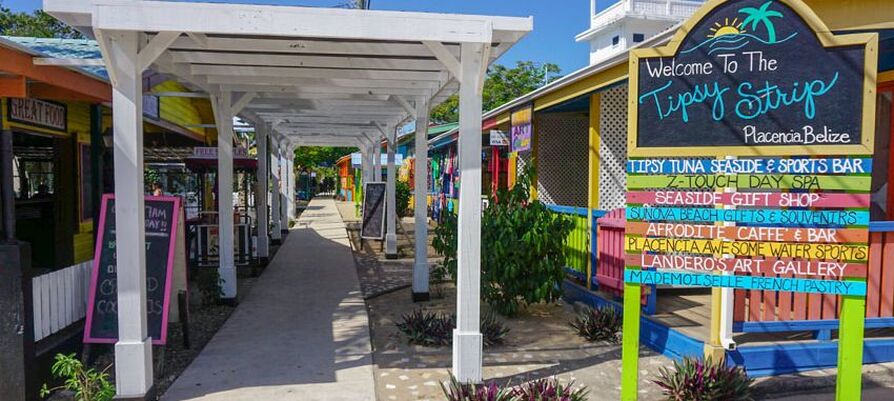
Sidewalk Strip
In Belize's lowkey tourist hangout, Placenaia, check out the world's narrowest street - its 4,071 feet long and four feet wide. Walking its length offers ample opportunities for shopping, eating, and getting a sense of village life.
In Belize's lowkey tourist hangout, Placenaia, check out the world's narrowest street - its 4,071 feet long and four feet wide. Walking its length offers ample opportunities for shopping, eating, and getting a sense of village life.
HOPKINS VILLAGE
Hopkins Village
This village is one an ultra-tranquil stretch of beach and can serve as a mellow base for canoeing, diving, sailing, windsurfing, fishing, and other trips - or for just doing nothing on the beach.
This village is one an ultra-tranquil stretch of beach and can serve as a mellow base for canoeing, diving, sailing, windsurfing, fishing, and other trips - or for just doing nothing on the beach.
LAUGHING BIRD CAYE
Laughing Bird Caye - National Park
Palmss, sand, snorkeling, and sun are found at this national park, part of a 10,000 acre protected marine area.
Palmss, sand, snorkeling, and sun are found at this national park, part of a 10,000 acre protected marine area.
GULISI GARINAGU MUSEUM
Gulisi Garinagu Museum
The long awaited cultural attraction is located on the outskirts of Dangriga and offers an interactive history lesson on the proud Garinugu (Garifuna) people. The Garifuna are a unique culture that formed some 400 years ago when African slaves imported into the Caribbean intermarried with local Arawak and Carib people. After engaging in several uprisings against the British on the island of St. Vincent, the Garifuna were forced to flee, arriving en masse on the shores of Belize in 1802. The Gulisi Garifuna Museum is dedicated to showcasing the rich cultural heritage of the Garifuna people.Founded in 1984, shortly after gaining independence from Great Britain, the Gulisi Garifuna Museum is named for one of the heroes of the Garifuna’s flight across the Caribbean. Gulisi was the name of a single mother with 13 children who founded the village of Punta Negra (in today’s Toledo District) after escaping persecution from the British and a lengthy trek across the Caribbean.
Today, the museum has multiple interactive exhibits on the Garifuna culture, including traditional drumming, Garifuna spiritual beliefs, a living full-size garden with traditional herbs and plants, and traditional dancing. There is also a special exhibition dedicated to showcasing some of the most famous musicians in Belize who were of Garifuna descent. In 2001, UNESCO declared that the Garifuna language, music and dance were invaluable contributions to the Oral and Intangible Heritage of Humanity.
The long awaited cultural attraction is located on the outskirts of Dangriga and offers an interactive history lesson on the proud Garinugu (Garifuna) people. The Garifuna are a unique culture that formed some 400 years ago when African slaves imported into the Caribbean intermarried with local Arawak and Carib people. After engaging in several uprisings against the British on the island of St. Vincent, the Garifuna were forced to flee, arriving en masse on the shores of Belize in 1802. The Gulisi Garifuna Museum is dedicated to showcasing the rich cultural heritage of the Garifuna people.Founded in 1984, shortly after gaining independence from Great Britain, the Gulisi Garifuna Museum is named for one of the heroes of the Garifuna’s flight across the Caribbean. Gulisi was the name of a single mother with 13 children who founded the village of Punta Negra (in today’s Toledo District) after escaping persecution from the British and a lengthy trek across the Caribbean.
Today, the museum has multiple interactive exhibits on the Garifuna culture, including traditional drumming, Garifuna spiritual beliefs, a living full-size garden with traditional herbs and plants, and traditional dancing. There is also a special exhibition dedicated to showcasing some of the most famous musicians in Belize who were of Garifuna descent. In 2001, UNESCO declared that the Garifuna language, music and dance were invaluable contributions to the Oral and Intangible Heritage of Humanity.
KEKCHI & MOPAN VILLAGES
Kekchi & Mopan Mayan Villages
The Kekchi and Mopan Mayan's settled in the lowland areas along rivers and streams, forming small isolated villages throughout the southern most region of Belize. Because of their isolation, the both groups have become the most self reliant ethnic group in Belize. They are also peaceful people known for their cooperative practices in farming and cultural development.
The Kekchi and Mopan Mayan's settled in the lowland areas along rivers and streams, forming small isolated villages throughout the southern most region of Belize. Because of their isolation, the both groups have become the most self reliant ethnic group in Belize. They are also peaceful people known for their cooperative practices in farming and cultural development.
